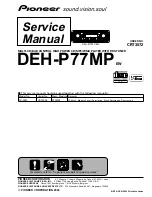
8.10 Checking autopilot operation
After completing calibration, check the basic autopilot
operation, as follows:
1. Steer onto a compass heading and hold a steady
course at normal cruising speed. If necessary,
steer the vessel manually for a short time to
check how the vessel steers.
2. Ensure it is safe to engage the autopilot, then
press
AUTO
to lock onto the current heading.
The autopilot should hold a constant heading in
calm sea conditions.
3. Use
-1
,
+1
,
-10
and
+10
or the
ROTARY
controller, to see how the SmartPilot alters the
course to port and starboard.
4. Press
STANDBY
to return to manual steering.
Checking rudder gain
To determine whether the rudder gain is set correctly,
carry out the following test:
D12107-1
1
2
3
Item
Description
1.
Rudder gain too low
2.
Rudder gain too High
3.
Correct rudder gain
1. Ensure you have set the autopilot response to
level 5.
2. Drive your vessel at a typical cruising speed in
clear water.
It is easier to recognize the steering response in
calm sea conditions where wave action does not
mask steering performance.
3. Press
AUTO
to enter Auto mode, then alter
course by 40°:
• This course change should result in a crisp turn
followed by an overshoot of no more than 5°, If
the rudder gain is adjusted correctly.
• If the course change causes a distinct
overshoot (more than 5°) and/or there is a
distinct ‘S’ in the course the rudder gain is too
high.
• If the vessel’s performance is sluggish and it
takes a long time to make the 40° turn, with no
overshoot the rudder gain is too low.
If necessary, adjust the rudder gain.
Checking counter rudder
Counter rudder is the amount of rudder your autopilot
applies to try to prevent your vessel from over
steering. A higher counter rudder setting results in
more rudder being applied.
To check the counter rudder setting:
1. Ensure you have set the autopilot response to
level 5.
2. Drive your vessel at a typical cruising speed in
clear water.
3. Press
AUTO
and if necessary engage the
autopilot.
4. Make a 90° course change:
• When rudder gain and counter rudder are both
set correctly, the vessel performs a smooth
continuous turn with minimal overshoot.
• If the counter rudder is too low, the vessel will
overshoot before returning slowly to the course.
• If counter rudder is too high, the vessel will
‘fight’ the turn and make a series of short,
sharp turns. This results in a very ‘mechanical’
feel as the vessel changes course.
5. If necessary, adjust the counter rudder setting.
Counter Rudder is available from the
Drive
Settings
menu:
Menu > Set-up > Autopilot
Calibration > Drive Settings > Counter Rudder
.
Rudder Damping
If the autopilot is ‘hunting’ (i.e. continuously moving
the steering backwards and forwards by small
amounts) when trying to position the rudder, the
rudder damping setting will require adjustment to
minimize this.
Increasing the rudder damping value reduces
hunting. The rudder damping value should be
increased 1 level at a time until the autopilot stops
hunting. Always ensure the lowest acceptable value
is used.
If required the Rudder Damping setting can be
adjusted from the Drive Settings menu:
Menu >
Set-up > Autopilot Calibration > Drive Settings >
Rudder Damping
.
AutoTrim settings
AutoTrim determines how quickly the autopilot
applies ‘standing helm’ to correct for trim changes,
caused, for example, by changes in the wind load
on the superstructure, or an imbalance of engines.
Increasing the AutoTrim level reduces the time the
autopilot takes to return to the correct course, but
makes the vessel less stable. If the autopilot:
• Gives unstable course keeping and the vessel
‘snakes’ around the desired course, decrease the
AutoTrim level.
• Hangs off course for excessive periods of time,
increase the AutoTrim level.
Commissioning - SPX and SmartPilot systems
57
Содержание P70
Страница 2: ......
Страница 4: ......
Страница 10: ...10 p70 p70R ...
Страница 14: ...14 p70 p70R ...
Страница 28: ...28 p70 p70R ...
Страница 29: ...Chapter 5 Installation Chapter contents 5 1 Mounting on page 30 Installation 29 ...
Страница 38: ...38 p70 p70R ...
Страница 48: ...48 p70 p70R ...
Страница 58: ...58 p70 p70R ...
Страница 68: ...68 p70 p70R ...
Страница 74: ...74 p70 p70R ...
Страница 75: ...Chapter 11 Pilot controller alarms Chapter contents 11 1 Alarms on page 76 Pilot controller alarms 75 ...
Страница 80: ...80 p70 p70R ...
Страница 94: ...94 p70 p70R ...
Страница 110: ...110 p70 p70R ...
Страница 118: ...118 p70 p70R ...
Страница 121: ......
















































